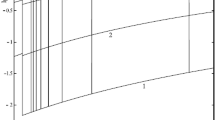Abstract
IT has been widely claimed that the background microwave radiation observed by Penzias and Wilson1 and Roll and Wilkinson2 must originate from a radiation dominant, early phase of the Universe. Hoyle and Wickramasinghe3 have, however, discussed the possibility of a more local origin for this radiation. They point out that the energy density arising from the conversion of hydrogen to helium in all galaxies is about 10−13 erg/cm3, close to the energy density of the 3° K blackbody field. If an appreciable fraction of this energy could be thermalized by dust grains the observed “black body” microwave spectrum might be explained. The requirement is that quantum oscillators covering much of the frequency range 0.01 cm−1 to 10 cm−1 are present in the grains. While arguments may be given for the presence of localized oscillation modes within this frequency range, the strongest evidence at the present time would seem to be for the existence of oscillators close to about 10 cm−1 (Sievers4, Sievers and Takeno5). Such frequencies may be appropriate for the oscillation of weakly bound substitutional impurities in crystals. In a typical case the oscillator strength could be about 0.1 and the line width about 1/10 of the central frequency4. We shall consider here the effect of a few strong emission bands at about 1 to 10 cm−1 which may be present in grains. From a total of about 1055 grains in the Galaxy each containing approximately 105 impurity oscillators we could obtain an infra-red emission at about 10 cm−1 equal to approximately 1/3 of the entire luminosity of the Galaxy. This flux of Galactic radiation at ν ∼ 10 cm−1 (1 mm wavelength) could produce the observed excitation of the J = 1 rotational levels of cyanogen (CN) (Field and Hitchcock6), but it would not account for the microwave observations1,2.
Similar content being viewed by others
References
Penzias, A. A., and Wilson, R. W., Astrophys. J., 142, 419 (1965).
Roll, P. G., and Wilkinson, D. T., Phys. Rev. Lett., 16, 405 (1966).
Hoyle, F., and Wickramasinghe, N. C., Nature, 214, 969 (1967).
Sievers, A. J., Phys. Rev. Lett., 13, 310 (1964).
Sievers, A. J., and Takeno, S., Phys. Rev., 140, A 1030 (1965).
Field, G. B., and Hitchcock, J. L., Phys. Rev. Lett., 16, 817 (1966).
Wickramasinghe, N. C., Interstellar Grains, 146 (Chapman and Hall, 1967).
Shephard, I., and Feher, G., Phys. Rev. Lett., 15, 194 (1965).
Feher, G., Shephard, I. W., and Shore, H. B., Phys. Rev. Lett., 16, 500 (1966).
Hoyle, F., and Tayler, R. J., Nature, 203, 1108 (1964).
Author information
Authors and Affiliations
Rights and permissions
About this article
Cite this article
NARLIKAR, J., WICKRAMASINGHE, N. Microwave Background in a Steady-state Universe. Nature 216, 43–44 (1967). https://doi.org/10.1038/216043a0
Received:
Issue Date:
DOI: https://doi.org/10.1038/216043a0
- Springer Nature Limited
This article is cited by
-
Interpretation of Cosmic Microwave Background
Nature (1968)
-
Upper Limits on Universal Microwave Radiation below λ = 1.7 mm
Nature (1968)
-
Microwave Background in a Steady State Universe
Nature (1968)
-
Spectrum of the 3° K Cosmic Microwave Radiation
Nature (1967)





